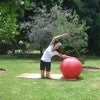Description
About This Video
Transcript
Read Full Transcript
So we will be working with straps today. And if you don't have a strap I in watching this video, what you'll be able to do is use a towel. The purpose of that is to stabilize more through the arm reach. So we'll be using that in a, in a moment as we roll down and roll up. So let's begin by breathing and finding the centers, the foot centers, the base of the big toe between the fourth and the fifth toe in the middle of the heel.
So you find that triangle that you're standing on and let yourself play a little bit with the weight shifts through the legs. We want to find the midline. So the ankle bones touch above the knee high on your thigh. You're pulling in and up on the inhale, lift your toes on the exhale. Lower your [inaudible]. We use the [inaudible] breath in through the nose.
You want to lift and then lower and
Straight down as if you're going to sit on your eels and tomorrow. Nice one more. And pulses. You're sure you're lengthening through the back of the legs to straighten the knees and eight more, four, three, two and
So for now it's just practicing what that is. So inhale, exhale, open the arms and inhale and lower the arms. You want to isolate the arm bone, the upper arm bone, and keep the back. Why the shoulder blades wide? So there's a space between the shoulder blades and you want that to open. She want to keep it open.
So you're using the muscle of your shoulders to stabilize. So what we're playing with tonight is we're playing with the stability of the spine and the mobility of the spine and the contrast of those two things. Right now we want to play with stability. Nothing of the spine is moving. We're holding this upright position. Shumar
Most of all, you want a relapse across the neck and shoulders. So you're learning to Shimmy. Collate the muscle of the arms, stability from the bat.
So you want to stimulate more of a classic platas. Fewer pull in and up, in and up. And then above the navel to the sternum, what I call the highest point. You wanna wrap sheer pulling in and up and wrapping. Last time.
Here's where we can get caught if we're not careful. So widen the shoulder blades. Let's just play with that for a moment. Reach the hands, expand the palms of the hands, let them go wide. Inhale, open, exhale and pull together and inhale, open. Exhale, pull together. This is the shoulder blades, not the arms short. Yeah, shoulder blades and shoulder blades and shoulder blades and one more shoulder blades. And keep the shoulder blades wide. Lengthen the spine and your round over. Arms, head, neck and shoulders and then round over to what I call the high points.
So stay there. Shoulder blades are pulled down, the lower belly pulls in and up. So you're lengthening the lower back. It stays upright, you're widening the back, the shoulder blades, the lower back stays upright, you're widening the back, the shoulder blades, the lower belly pulls in and up. You're widening the back. Pull the shoulder blades down and wide. Very good. [inaudible] shoulder blades down and wide. Now we round over into the Lumbar, take the fingertips towards the toes, rounding over and then all the way over your fingertips are floating above the floor. Pull in and up from the lower belly. So you want to get a sense of widening and lengthening the whole spine.
So now we're creating a mobility of the spine. On the inhale, lift your toes on the exhale. Lower your toe as you want to. Find the balance and relax the neck and shoulders. Keep letting the head drop towards the toes.
Then the thoracic rib cage in place. Then the neck and the head. So what I play with in classes to avoid this to happen, causing the head to go forward, we want to play with the lifting of the spine between the shoulder blades, working more, the intercostals. Also working into the introverted roles of the lower back.
Rounding over only to the base of the rib cage. Stay there for a moment. Reach your fingertips forward, expand the hands. So widen the web spaces. Then allowing the head to round over into the lumbar. The lower back and rounding over all the way. Stay lifted in the lower belly shoulder blades into their pockets and wide crown of the head of the toes. Any pulse
Four three two. Let your arms swing down or roll up. Sacrum and Lumbar, lower back and thoracic ribcage. Keep the shoulder blades wide, neck and head
Neck and head were going down to get the strap. This time when you come up, take hold of the middle of the strap with your fingers in, you're holding it, just letting it hang. Head, neck, shoulders and arms. Then thoracic ribcage than the lumbar. Lower back, yes. And running over into the sacred. Although way they hold in the middle of the strap and rolling up sacrum in place and Lumbar, lower back, lengthening the spine as you go wide the shoulder blades. So rassic rib cage and then neck and head
So if you were using Italian, you would just hold the towel. You'd roll the talent, hold it. Here. The straps are nice cause you get a little bit more friction in the, um, the holding of it without gripping and hanging on. So we're here. Expand the fingers. I'm finding this most recently, if you expand the fingers, very jazzy hands, it allows you to reach more out. If you don't, then you'll tend to get caught in your ligaments. So I want to say that you're using the muscle dynamic. In a, in my practice of neo, we would call this positive tension.
We want to get that positiveness of the energy of the muscles reaching, getting longer and overhead. Keep the shoulders down. I can always tell when someone's in their shoulders is when the trapezius swell up here to want to open the neck. Let it widen, reach the fingertips up and take the arms behind you. Now your opposing force is at high point here. Pull back from the high point. So as you're reaching your arms behind you, your chest stays wide, your spine stays lifted so that the strap is, is taught and you reach the backs of your hands behind you. Your high point as your opposing force and eight more four, three, two and reach out as if you're going to touch the wall in front of you and then come all the way down.
Keep the chest lifting so you don't get caught in the shoulder blades. But instead you allow the arms to move. I'm getting into the playing with the differentiation. We want the arm to be different than the shoulder blade. Want the arm to be different than the neck.
So let's play with that a little bit more. Do this two more times
Your opposing force is still coming from the front of you from the what I call the low point up to the high point that's pulling in and up and wrapping around. Two more
Allowing the muscle to stimulate even more. And eight more. Four, three overhead and eight four, three at the chest and eight shoulders down. Widen the bash. And Four
Two, two. If you need to release the legs, just go ahead and play a yeah, that will help you. Yeah, that helps. Takes cause what happens is getting used to standing takes different muscularity. Yeah. Good. We're here
So we're stabilizing the spine here, mobilizing the ball and socket. Now removing the head of the Femur, the top of the femur bone, not the feet. The feet. Follow the legs. Okay. She followed the legs one more and
So you're rotating on the access of your spa. You're moving your torso, not your arms, your arms. Stay with your torso and rotate, rotate, rotate. You want to keep your focus through the middle of the strap so you're not even turning your head. Your head is going with the rotation. So your eyes stay forward. Over the middle of the strap. One more
There is a ring that goes on inside the spine when we rotate on the of the spine. If we release that access, then we tend to get tweaked out in the hips and the knees. So we want to stay more on the central axis. Let's do this again. Single breath. Now inhale here
What a focus on linkedin. The opposing side. So here you lengthen on the left side, left side, left side and right side. Right side, very good. And two more left side. Left side, left side. Last time. Right side or right side or right side. And stay single. Breath to rotate.
Yeah. I've got to learn to pronounce the w different than the [inaudible] ringing. Ringing. So we're here. Ready to get there. What's that? Musical isn't, we can make it a musical. This, this is the uh, the driver's room. We'll make the musical version next time. So we're here. Let's go back to the um, or let's return to the side bend.
Now let's make it a hip stretch. So lead with the hip. It's the left hip. It's the right hip and left hip, Scheisse and right hip shorted the left hip. Again, reaching out here. I love this pattern. This is something to get involved with. To open up the QL, the muscles here below the rib cage into the waistline. It allows you to sense your body differently and opening the side.
The left arm pulses. Keep the shoulder down. Keep reaching out with your right arm. Eight more. Here you can move into the left side of the ribcage and it's ribs, ribs. It'll take some finding to find the muscularity that lists the rib cage off the hip and for three now the hips stretch and hip here. Keep the torso still so the arms, head, neck, and shoulders are not moving.
And eight more for three, two and hip stretch this time it's the right arm and it's arm, arm, arm and arm. Rib Cage and ribs, ribs, ribs and ribs and hip, hip, hip, hip and hip. Hip, hip, hip, eight more and four three, two and
She want to feel that sense of lengthening through the waistline.
So there's no bending forward. It's only a rounding forward stop for a moment. So there's a confusion sometimes when we get into this appropriate section of the muscle. So what I want to see is it's not going this way. What I want to see is the articulations coming from the lower back, staying still. So the articulation comes from the base of the spine over. So that's a mobility issue. It's like a wave. Yeah, yeah.
It rather than rather than pitch forward from the back, because we will get too tight in our lower backs if we're not careful. This allows us stretch to happen so that we can create more mobility there.
It allows you to expand differently, particularly across the back and shoulders. Yeah.
One more. Keep pulling the shoulder blades down and why particularly when you come up and you inhale here. Exhale to contract. Inhale to come up. Use the longer inhale, allow your spine to find its full length. When you come up all the way crown of the head and then over come up all the way crowded, the head reaches to the Strap and oh, but that's very nice. And two more times. And reach to the strap.
Shoulder blades down and wide and contract from the intercostal band or the rib cage, the rim of the rib cage and the over and come up and arms down for a rest. Yeah, getting to find more space between the, the, the Vertebra also, it allows you to expand the back. I particularly like this, this position here. Uh, and this allows this to open even wider chest expansion. Tough part about this work and always has been classic work or otherwise to learn how to expand the chest without compromising another body part. Let's play with this
Now we add the contraction and rotate side bend and contract come up and center and rotate. Sidebench and contract come up very good and
Think of up and over. So you're focusing the crown of the head of the strap and it's, we'll go over four, three, two and one. Each one of those is a breath. Your high point is your opposing force. A pull in on the intercostals, allowing yourself to find even more mid back from here. So we're here and try not to head an over four high and three
Shh. You're looking out of your forehead or looking pat. Yes. Nice, nice correction. Look out, look out. Not down or up. Look out. Pull in on the intercostal from the front right beneath the sternum. Excellent. Come up to upright, arms down. That was a good start. I love seeing that. That's one of the most opening gestures a human body can do to allow the chest to open without the compromise of the neck and shoulders.
Let's do it one more time
This is a takeoff on that feeling of what we can do on a spine corrector. So let's, let's not add the side bend a pattern yet. Let's go ahead with it. I might have an angle so you can see what's going on here. So overhead
I can't see it cause I was thinking about it. Yeah. So let's go through it again. Yeah, let's mark it slow so we don't, and then we'll make it flow. We're here.
Spine mechanics. So that's the mobility, the pivot points at the base of the spine. I like to think of the, the middle of the neck, the neck going straight down. Somewhere in there, somewhere in there is the middle of the neck. It's like a a root. So I think of that. So what I want to do is I want to be pivoting on the base of the root. So let's just go ahead into a side bend and go around. So let me show you what I'd like to see.
Then I want to watch and see what I need to correct. So it'll look like this.
A lot of energy begins to move. It's just what starts happening. Circumlocution so we've done lateral, we've done forward, we've done extension, we've done circumlocution and rotation. So let's be done with the standing work for now. Nice to see. It's what so much fun to see is when people know the work and does that, what is, ah, I love those moments. I just, that's so important to me because that's why I like going back to the classic work, cause I have this other, I have all these variations going on and when I go back to the classic work, it's right there for me. All of it. Yep.
Comments
You need to be a subscriber to post a comment.
Please Log In or Create an Account to start your free trial.













